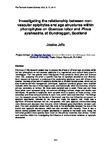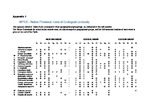Investigating the relationship between non-vascular epiphytes and age structures within phorophytes on Quercus robur and Pinus sylvestris, at Dundreggan, Scotland
| dc.contributor.author | Jaffa, J. | |
| dc.date.accessioned | 2019-05-15T15:01:23Z | |
| dc.date.available | 2019-05-15T15:01:23Z | |
| dc.date.issued | 2013 | |
| dc.identifier.citation |
Jaffa, J. (2013) 'Investigating the relationship between non-vascular epiphytes and age structures within phorophytes on Quercus robur and Pinus sylvestris, at Dundreggan, Scotland', The Plymouth Student Scientist, 6(1), p. 32-71. | en_US |
| dc.identifier.issn | 1754-2383 | |
| dc.identifier.uri | http://hdl.handle.net/10026.1/14007 | |
| dc.description.abstract |
The focus of this research project was to analyse the effects of different age structures within the host phorophyte on non-vascular epiphytes in a fragmented, semi-natural forest stand in Dundreggan. Two tree species were investigated Pinus sylvestris, Scots pine and Quercus robur, oak, analysing the effect a specific tree has on epiphyte abundance and diversity. Such research is important to understand the relationship epiphytes have with different tree species, focusing on patterns of epiphytic distribution at different spatial scales, which can be later implemented into management techniques. Epiphytic functional groups were stratified vertically within the tree in three height zones, and horizontally within the branches, whether primary, secondary or tertiary. Six trees were sampled over a week. Three oak and three Scots pines were accessed using two common climbing methods; single and double rope techniques. All species of epiphytes were sampled within a quadrat on three primary, three secondary and three tertiary branches in each zone, which were later identified. The findings from the research proved that the size of the branch was the most influential component on epiphytic abundance, followed by the zone and finally the specific tree. There was a significant difference between the two tree species, with oaks epiphytic communities being more diverse and abundant than the pine, which indicated great dissimilarity between sub-plots. The main conclusion drawn from this study is the relationship between the size of the branch and epiphytic abundance, which can also correlate with maturity. There is also a distinct vertical gradient with a higher abundance of species in the lower zone. Along the horizontal gradient more species were found on the primary branches than tertiary. Further work would be viable into investigating the influence of environmental variables on epiphytic abundance. | en_US |
| dc.language.iso | en | en_US |
| dc.publisher | University of Plymouth | |
| dc.rights | Attribution 3.0 United States | * |
| dc.rights.uri | http://creativecommons.org/licenses/by/3.0/us/ | * |
| dc.subject | non-vascular epiphytes | en_US |
| dc.subject | tree species | en_US |
| dc.subject | Pinus sylvestris | en_US |
| dc.subject | Scots pine | en_US |
| dc.subject | Quercus robur | en_US |
| dc.subject | oak | en_US |
| dc.subject | Epiphytic functional groups | en_US |
| dc.subject | Dundreggan, | en_US |
| dc.subject | Scotland | en_US |
| dc.title | Investigating the relationship between non-vascular epiphytes and age structures within phorophytes on Quercus robur and Pinus sylvestris, at Dundreggan, Scotland | en_US |
| dc.type | Article | |
| plymouth.issue | 1 | |
| plymouth.volume | 6 | |
| plymouth.journal | The Plymouth Student Scientist |




